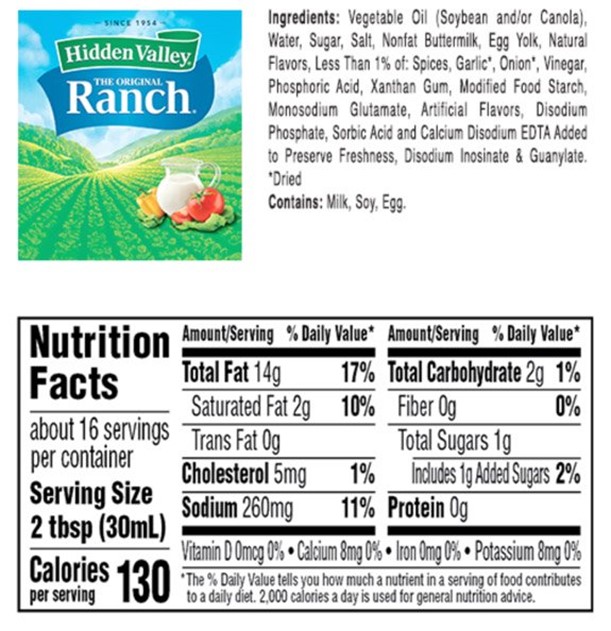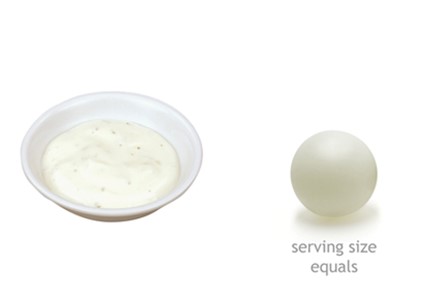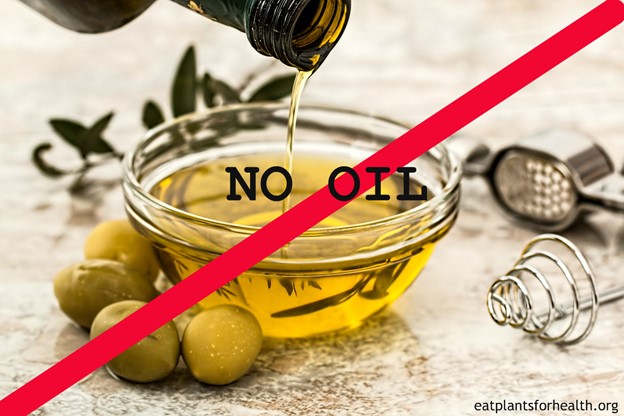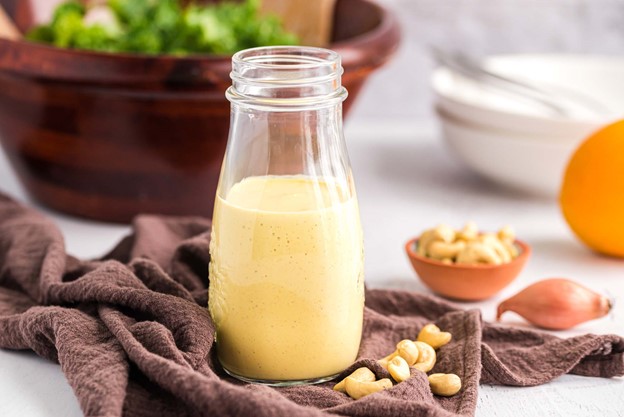It’s a FOOD REVOLUTION: Dressings DO NOT Need OIL to Taste Good!
We know that salads are healthy, but all the healthy-ness they provide can be undone when we top them with dressings that are full of dangerous fats, artificial ingredients, and over-the-top levels of sodium.
A look at a popular salad dressing from the supermarket can give us a sense of how salad dressings can go terribly wrong (from a nutritional standpoint). Here’s what Hidden Valley The Original Ranch® has to offer:

The only ingredients listed that you’d probably want to put in your body are the water, dried garlic, and onion. The soybean and/or canola oil (the first and therefore the largest ingredient by weight) are both high in omega-6 fatty acids (of which most of us get way too much). And as they aren’t certified organic, the oils almost certainly come from GMO plants.
The next largest sources of calories are the sugar, buttermilk, and egg yolk. “Natural flavorings” typically are chemical concoctions that are anything but natural. And hiding in the “less than 1%” ingredients are MSG, modified food starch (also GMO), artificial flavorings, and a mess of unpronounceable chemical names.
And another big concern with store-bought salad dressings is their suggested serving size is. For the average person, this is a totally fictional concept. The mandated serving size for salad dressing, as you can see on the Hidden Valley label (above) is two tablespoons. Honestly, who uses just two tablespoons? The photo below shows just what 2 tablespoons of dressing looks like—about the size of a ping pong ball. Most of us cover our salad with a lot more than 2 tablespoons!

I don’t mean to give the impression that all salad dressings are bad. Or that you have to eat your lettuce and carrots completely undressed. There definitely are some clean brands and varieties of organic commercial dressings available. And of course, there’s always homemade. Homemade dressing is the better choice because not only can you control all the ingredients, they’re much less expensive than store-bought (and fresher as well).
But still, even though you’re probably not adding your own red dye #40 or MSG when you’re making your own, many homemade dressing recipes still use oil as one of the first two ingredients. After all, the simplest dressing of around is called “oil and vinegar.” Nevertheless, current research says this simple dressing may not be the healthiest option.
With that said, are we doomed to choke down bland, undressed leafy greens? Or can we liven up our salads with dressings that are as healthy and friendly to our waistlines as the veggies they’re coating? The exciting answer to the first question is NO! And the exciting answer to the second question is YES!

It’s completely possible to make a truly delicious dressing without oil. I know this firsthand. I subscribe to a marvelous newsletter from FOOD REVOLUTION NETWORK, and in the latest edition they sent information on how to make healthy dressings minus the oil.
While oil can add flavor, moisture, mouthfeel to a salad, and serve as an effective transport mechanism for fat-soluble nutrients and flavorings, it’s not the only way to accomplish any of these functions.

There are some tasty fat-containing, health-building whole foods that are excellent alternatives to oil. Tahini (sesame paste), nuts, seeds, or beans pureed in a blender with a little water, lemon juice, vinegar, or soy sauce, pureed organic tofu, avocados, and plant-based yogurts are all healthy substitutes.
I’ll close with one of the recipes FOOD REVOLUTION NETWORK provided in their article. It’s made with citrus and cashews (which replace oil and give the dressing a creamy mouthfeel).
And by the way, a good dressing isn’t just for salad. It can also be yummy on grains, tossed with steamed vegetables, added to a stir-fry and tacos, drizzled over potatoes, or even used as a marinade. Make extra, so you can enjoy it all week! (P.S. If you’d like to scout out their other oil-free dressing recipes, just go to https://foodrevolution.org/blog/oil-free-salad-dressings.)

1/2 cup cashew nuts (soaked in water for 4–6 hours, to soften and remove phytates)
1/2 cup orange juice (freshly squeezed from one large or two medium organic navel oranges)
2 tablespoons orange zest (zest before juicing)
1 medium lemon (juiced)
1 tablespoon apple cider vinegar
1 tablespoon sesame tahini
1 shallot (chopped)
salt (to taste)
pepper (to taste)
Directions:
A look at a popular salad dressing from the supermarket can give us a sense of how salad dressings can go terribly wrong (from a nutritional standpoint). Here’s what Hidden Valley The Original Ranch® has to offer:

The only ingredients listed that you’d probably want to put in your body are the water, dried garlic, and onion. The soybean and/or canola oil (the first and therefore the largest ingredient by weight) are both high in omega-6 fatty acids (of which most of us get way too much). And as they aren’t certified organic, the oils almost certainly come from GMO plants.
The next largest sources of calories are the sugar, buttermilk, and egg yolk. “Natural flavorings” typically are chemical concoctions that are anything but natural. And hiding in the “less than 1%” ingredients are MSG, modified food starch (also GMO), artificial flavorings, and a mess of unpronounceable chemical names.
And another big concern with store-bought salad dressings is their suggested serving size is. For the average person, this is a totally fictional concept. The mandated serving size for salad dressing, as you can see on the Hidden Valley label (above) is two tablespoons. Honestly, who uses just two tablespoons? The photo below shows just what 2 tablespoons of dressing looks like—about the size of a ping pong ball. Most of us cover our salad with a lot more than 2 tablespoons!

I don’t mean to give the impression that all salad dressings are bad. Or that you have to eat your lettuce and carrots completely undressed. There definitely are some clean brands and varieties of organic commercial dressings available. And of course, there’s always homemade. Homemade dressing is the better choice because not only can you control all the ingredients, they’re much less expensive than store-bought (and fresher as well).
But still, even though you’re probably not adding your own red dye #40 or MSG when you’re making your own, many homemade dressing recipes still use oil as one of the first two ingredients. After all, the simplest dressing of around is called “oil and vinegar.” Nevertheless, current research says this simple dressing may not be the healthiest option.
With that said, are we doomed to choke down bland, undressed leafy greens? Or can we liven up our salads with dressings that are as healthy and friendly to our waistlines as the veggies they’re coating? The exciting answer to the first question is NO! And the exciting answer to the second question is YES!

It’s completely possible to make a truly delicious dressing without oil. I know this firsthand. I subscribe to a marvelous newsletter from FOOD REVOLUTION NETWORK, and in the latest edition they sent information on how to make healthy dressings minus the oil.
While oil can add flavor, moisture, mouthfeel to a salad, and serve as an effective transport mechanism for fat-soluble nutrients and flavorings, it’s not the only way to accomplish any of these functions.

There are some tasty fat-containing, health-building whole foods that are excellent alternatives to oil. Tahini (sesame paste), nuts, seeds, or beans pureed in a blender with a little water, lemon juice, vinegar, or soy sauce, pureed organic tofu, avocados, and plant-based yogurts are all healthy substitutes.
I’ll close with one of the recipes FOOD REVOLUTION NETWORK provided in their article. It’s made with citrus and cashews (which replace oil and give the dressing a creamy mouthfeel).
And by the way, a good dressing isn’t just for salad. It can also be yummy on grains, tossed with steamed vegetables, added to a stir-fry and tacos, drizzled over potatoes, or even used as a marinade. Make extra, so you can enjoy it all week! (P.S. If you’d like to scout out their other oil-free dressing recipes, just go to https://foodrevolution.org/blog/oil-free-salad-dressings.)

Creamy Citrus Dressing
Ingredients:
1/2 cup cashew nuts (soaked in water for 4–6 hours, to soften and remove phytates)
1/2 cup orange juice (freshly squeezed from one large or two medium organic navel oranges)
2 tablespoons orange zest (zest before juicing)
1 medium lemon (juiced)
1 tablespoon apple cider vinegar
1 tablespoon sesame tahini
1 shallot (chopped)
salt (to taste)
pepper (to taste)
Directions:
Place all ingredients in a food processor or small blender and blend until smooth. Adjust flavors with extra orange juice, lemon, or salt and pepper if desired.
SUBSTITIONS: You can always substitute any juicy orange if you can’t find navel oranges. You can use yellow or green onions in place of the shallot, if need be. And you can use extra orange juice in place of the lemon.
PREP AHEAD: Creamy Citrus Dressing will keep for 5 to 7 days in a well-sealed container in the refrigerator.
SUBSTITIONS: You can always substitute any juicy orange if you can’t find navel oranges. You can use yellow or green onions in place of the shallot, if need be. And you can use extra orange juice in place of the lemon.
PREP AHEAD: Creamy Citrus Dressing will keep for 5 to 7 days in a well-sealed container in the refrigerator.
Recipe formatted with the Cook'n Recipe Software from DVO Enterprises.
Sources:
- www.foodrevolution.org
- www.mydietanalysis.pearsoncmg.com
- www.tuscantraveler.com
- www.eatplantsforhealth.org.
 Alice Osborne
Alice Osborne
Weekly Newsletter Contributor since 2006
Email the author! alice@dvo.com
